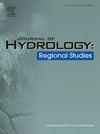Significant differences in terrestrial water storage estimated by four common methods
IF 4.7
2区 地球科学
Q1 WATER RESOURCES
引用次数: 0
Abstract
Study region
The Yellow River headwaters, located in the northeastern part of the Tibetan Plateau.
Study focus
Terrestrial water storage can be estimated by multiple approaches. However, the limited quantification of these methods regarding terrestrial water storage stocks limits the assessment of their applicability. Here, we quantified and compared water storage and its spatial patterns by four common methods: SWAT, InVEST, WB (based on water balance theory), and RSI (remotely sensed inversion).
New hydrological insights for the region
The results showed that SWAT, InVEST, and WB captured remarkable spatial heterogeneity of water storage, with CV (coefficient of variation) being 57.8 %, 41.2 %, and 85.2 %, respectively, whereas the CV of RSI was only 12.5 %, with WB exhibited the most spatial heterogeneity. RSI showed a pronounced distinct spatial pattern compared to the other three methods. Precipitation and NDVI (p < 0.01) are the common main drivers for all methods except RSI. The discrepancies in water storage can be attributed to the differences in models or methods response to influencing factors, e.g., the effects of topography and land use on water storage are considered to varying degrees. The biases or errors in the average water storage caused by different methods across various years range from 90.3 mm to 136.3 mm. Consequently, it is critical to consider the applicability of the methodology, especially considering different climatic, land use, soil, and topographic environments.

求助全文
约1分钟内获得全文
求助全文
来源期刊

Journal of Hydrology-Regional Studies
Earth and Planetary Sciences-Earth and Planetary Sciences (miscellaneous)
CiteScore
6.70
自引率
8.50%
发文量
284
审稿时长
60 days
期刊介绍:
Journal of Hydrology: Regional Studies publishes original research papers enhancing the science of hydrology and aiming at region-specific problems, past and future conditions, analysis, review and solutions. The journal particularly welcomes research papers that deliver new insights into region-specific hydrological processes and responses to changing conditions, as well as contributions that incorporate interdisciplinarity and translational science.
 求助内容:
求助内容: 应助结果提醒方式:
应助结果提醒方式:


